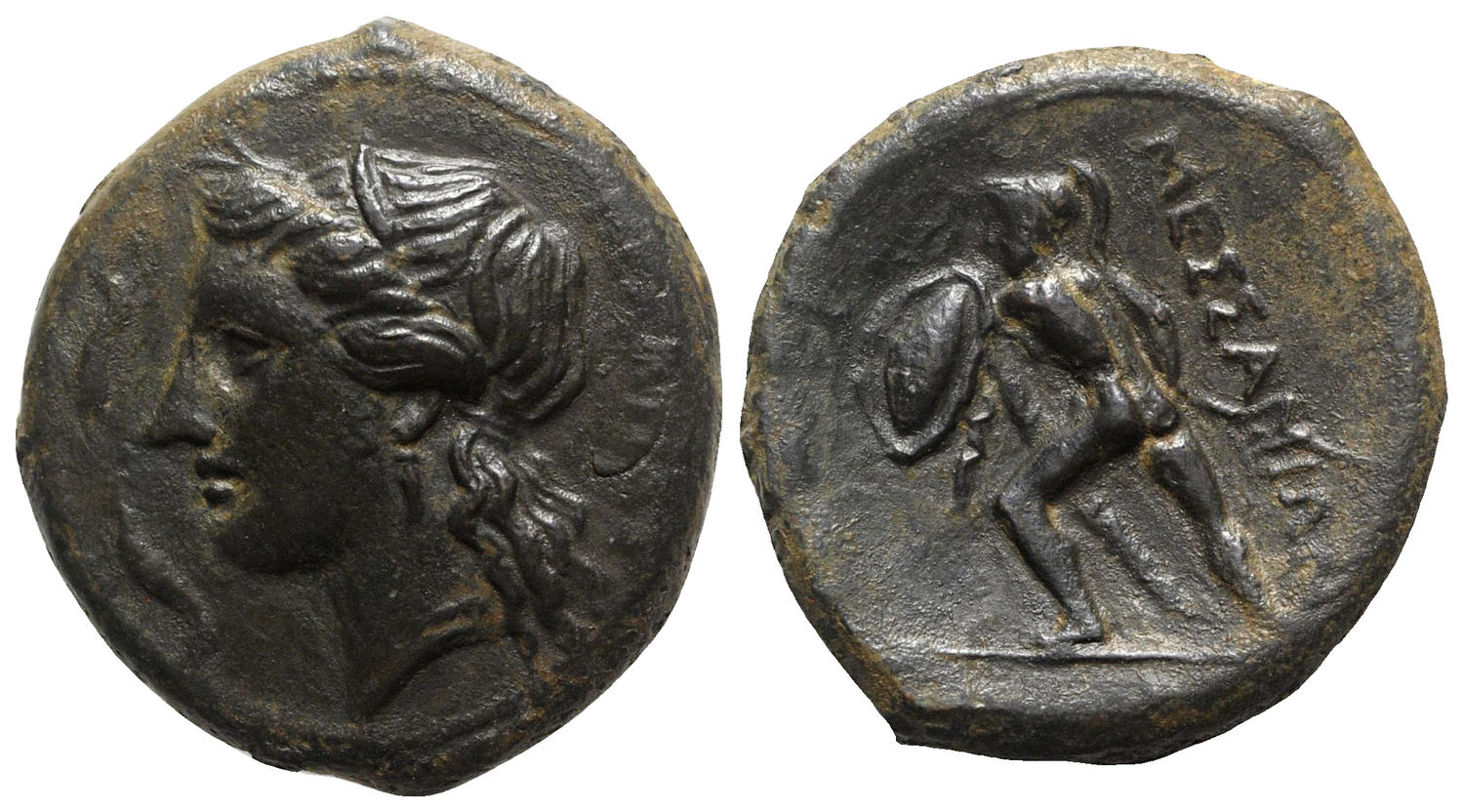H 27 - Messana, bronze, litrai (310/5-288 BCE)
From SILVER
310 BCE - 288 BCE Bronze
Description
| ObverseInscription or printing placed on the obverse.: | ΠΕΛΩPΙΑΣ (Greek).Wreathed head of Pelorias l., wearing single-pendant earring and necklace, two dolphins before |
| ReverseInscription or printing placed on the reverse.: | MEΣΣΑΝΙΩΝ (Greek).Nude warrior (Pheraimon?) advancing l., wearing crested helmet, holding round shield and spear |
Mint and issuing power
| MintIdentifies the place of manufacture or issue of a numismatic object.: | Messana | Ancient regionAncient region.: | Siicily | Modern countryModern country: Italy | AuthorityIdentifies the issuing power. The authority can be "pretended" when the name or the portrait of X is on the coin but he/she was not the issuing power. It can also be "uncertain" when there is no mention of X on the coin but he/she was the issuing power according to the historical sources: |
Chronology
| FromIdentifies the initial date in a range assigned in a numismatic context. | 310 BCE | toIdentifies the final date in a range assigned in a numismatic context.. | 288 BCE | PeriodTime period of the numismatic object.: Hellenistic 323-30 BC |
Physical description
| MetalThe physical material (usually metal) from which an object is made.: | Bronze |
Median weightMedian of the weights of numismatic objects (in grams). in grams | 8.20 | DenominationTerm indicating the value of a numismatic object. Examples: tetradrachm, chalkous, denarius.: | litra |
StandardStandard.: |
Image

H 27 - Messana, bronze, litrae (310-5-288 BCE).jpg [1]
References
| Die study referencePublication of the study: | Caccamo Caltabiano 19931Caccamo Caltabiano 1993, n° 808-877 | ||
| Coin series referenceReference to coin series study: | RQEMH2RQEMH, n° 27, Sear I3Sear I, n° 1136, HGC 24HGC 2, n° 834 | ||
Obverse dies distribution
| FrequencyFrequency of specimen in distribution. ᵖ | Number of obversesNumber of obverse dies. ᵖ (o) | % (o) | Number of coinsNumber of coins. (n) | % (n) | Die nameName(s) of the die(s). |
| 1 | 24 | 50 | 24 | 22.02 | 1, 4, 5, 6, 8, 15, 17, 20, 27, 28, 30, 32, 34, 35, 36, 37, 38, 39, 40, 41, 43, 45, 47 |
| 2 | 9 | 18.75 | 18 | 16.51 | 7, 12, 18, 21, 25, 26, 31, 33, 48 |
| 3 | 4 | 8.33 | 12 | 11.01 | 14, 19, 16, 44 |
| 4 | 3 | 6.25 | 12 | 11.01 | 11, 29, 42 |
| 5 | 5 | 10.42 | 25 | 22.94 | 2, 3, 23, 24, 46 |
| 6 | 3 | 6.25 | 18 | 16.51 | 9, 13, 22 |
| Total | 48 of 48 | 100 | 109 of 109 | 100 |
Reverse dies distribution
no distribution is available
Quantification
| Number of obversesNumber of obverse dies. ᵖ (o) | 48 | Number of singletons (o1)The number of singleton coins. ᵖ | 24 |
| Number of reverse diesNumber of reverse dies. (r) | 59 | Number of coinsNumber of coins. (n) | 109 |
| Coins per obverse dieNumber of coins per obverse die. (n/o) | 2.27 | Coins per reverse dieNumber of coins per reverse die. (n/r) | 1.85 |
| Reverse per obverse ratioRatio of obverse dies divided by reverse dies. (r/o) | 1.23 | Percentage of singletons (o1)number of coins (n) divided by the number of singletons (o1) ᵖ | 50 % |
| Original number of dies (O) (Carter 1983 formula)The estimation of the number of coins according to Carter 1983 ᵖ | 70.94 | Coins struck if 20,000 as average productivity per dieCoins made if the average productivity for obverses (according to Carter) is 20,000. ᵖ | 1,418,800 |
| Original number of dies (O) (Esty 2011 formula)The estimation of the number of coins according to the singleton formula in Esty 2011 ᵖ (O) | 85.77 | Survival rate if 20,000 as average productivity per dieSurvival rate if average productivity is 20,000. ᵖ | 0.00008 |
| Coverage (o = % of O) (Esty 1984 formula)Esty 1984 - coverage (% of O) ᵖ (o = % of O) | 77.98% | Die productivity if survival rate 1/2,000Average productivity if survival rate is 1/2,000. ᵖ | 3,073.02 |
| Weight of silver (in kg) if 20,000 coins per die (O = Carter formula)Carter 1983 * Median weight * 20000 (*10 if gold or electrum) ᵖ | n.a. | Die productivity if survival rate 1/5,000Average productivity if survival rate is 1/5,000. ᵖ | 7,682.55 |
Remarks
Most likely one single workstation